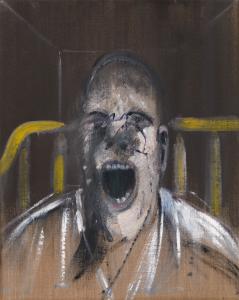Looking for design inspiration? Browse our curated collections!
March 21st, 2016 - 06:58 AM

Francis Bacon in his studio
Due to his asthma, Bacon was unable to join the armed forces during WWII. He was accepted as a member of the Air Raid Precaution sector, which involved non-military search and rescue, only to be discharged when he fell ill from the dust and rubble. "If I hadn't been asthmatic, I might never have gone onto painting at all," he admitted. After the war, he took up painting with a renewed passion, regarding Three Studies for Figures at the Base of a Crucifixion (1944) as the true beginning of his work. The long necks, snapping mouths and contorted bodies featured in the painting express horror and suffering, a forceful commentary on the aftermath of the war. Bacon modeled the figures after photos of animals in motion, showing an early interest in the movement of the body that became a strong theme in his later painting. During its exhibition at Lefevre Gallery critics were mostly shocked by the blatant imagery, but the numerous reviews put Bacon into the spotlight.
Mature Period
His breakout success at the 1944 exhibition gained him further opportunities to show with Lefevre. Graham Sutherland, a friend and fellow exhibitor, also recommended him to the director of Hanover Gallery, where Bacon had his first solo exhibition in 1949. For this show Bacon painted a series entitled Heads, significant for being the first series to introduce two important motifs: the first was the scream, derived from a film still drawn from Sergei Eisenstein's Battleship Potemkin in which an injured schoolteacher is shown screaming [in pain?]; the second is Diego Velazquez's Portrait of Pope Innocent X (c.1650), a painting Bacon only knew through reproductions (and which he would always maintain never to have seen in the original). The Heads series also made greater use of enclosing devices that suggest a pervasive sense of claustrophobia and anxiety, in this instance a shallow cage-like outline which Bacon had also employed in Three Studies from 1944.
Francis Bacon Biography
In 1953, Hanover held an exhibition of Bacon's paintings that included Two Figures, a depiction of two men embracing in bed, an image that created a huge scandal. The composition was based upon photographs of wrestlers taken by the Victorian photographer Eadweard Muybridge (1830-1904). Bacon preferred to work from photographs, relying on his friend John Deakin to take pictures of his subjects, but he was fascinated by Muybridge's attempts to capture and record bodies in motion. Bacon kept a collection of Muybridge's books in his studio as a constant source of reference, and even suggested that his intensive study of these sequential photographs triggered his own interest in working in series.
Bacon's tendency to derive inspiration from personal experiences also attracted him to portraiture. He often painted close friends (Lucian Freud, Isabel Rawsthorne,Michel Leiris), and the results convey a striking emotional and psychological intensity. One of Bacon's most famous subjects was his friend and lover George Dyer, who he met in 1964. During the course of their relationship, Bacon executed numerous portraits of Dyer that juxtaposed a strong musculature with a feeling of vulnerability, as in Portrait of George Dyer Crouching (1966), suggesting an affectionate yet protective attitude toward the younger man. Dyer suffered from alcoholism and episodes of depression, ultimately committing suicide on the night before Bacon's first retrospective in France in 1971.
Late Years and Death
Francis Bacon Photo
After the Paris exhibition Bacon moved increasingly toward self-portraiture, claiming, "people around me have been dying like flies and there is nothing else to paint but myself." Continuing to work steadily, he completed a number of paintings in tribute to Dyer's memory. Many of these took the form of large format triptychs, including the well-regarded "Black triptych" series that recounted the details of Dyer's passing. In 1973, Bacon became the first contemporary English artist to have a major exhibition at the Metropolitan Museum of Art in New York. His work was exhibited internationally throughout the later years of his life, including retrospectives at the Hirshhorn and the Tate Gallery. In the mid 1970s, Bacon met John Edwards, who replaced both Dyer and Deakin as Bacon's constant companion and photographer. In his last years, Bacon retreated from his formerly boisterous social life, focusing on his work and the platonic relationship with Edwards. He died of a heart attack in Madrid at the age of 81.
Legacy
Bacon's unique interpretations and the intensely personal nature of his work make it difficult to visually trace his influence in contemporary art. Nevertheless, his paintings have inspired some of the most standout artists of this generation, including Julian Schnabel and Damien Hirst.
John Edwards, who inherited the estate, played an important role in promoting Bacon's work until his death in 2003. He was responsible for the donation of Bacon's studio to the Hugh Lane Municipal Gallery of Modern Art in Dublin, and this was turned into a permanent exhibition and research archive.
Comments
There are no comments on this blog. Click here to post the first comment.